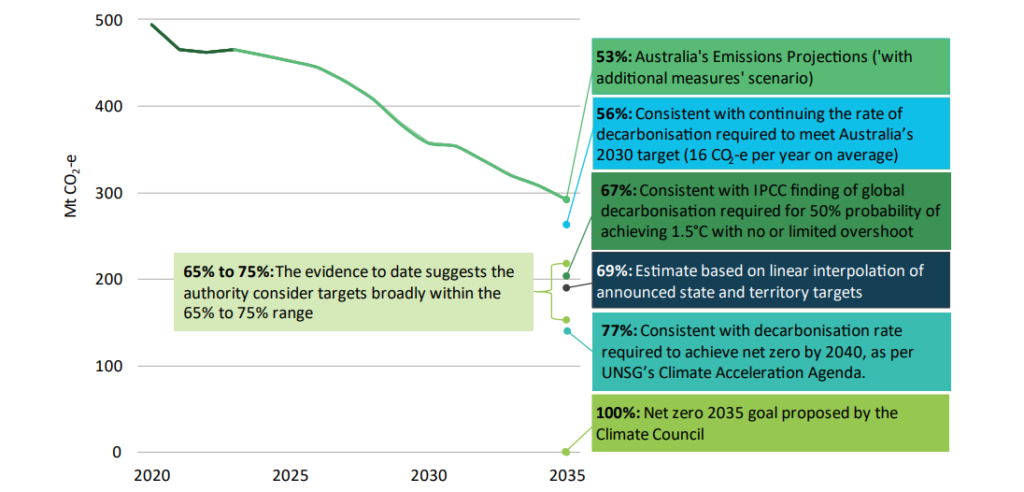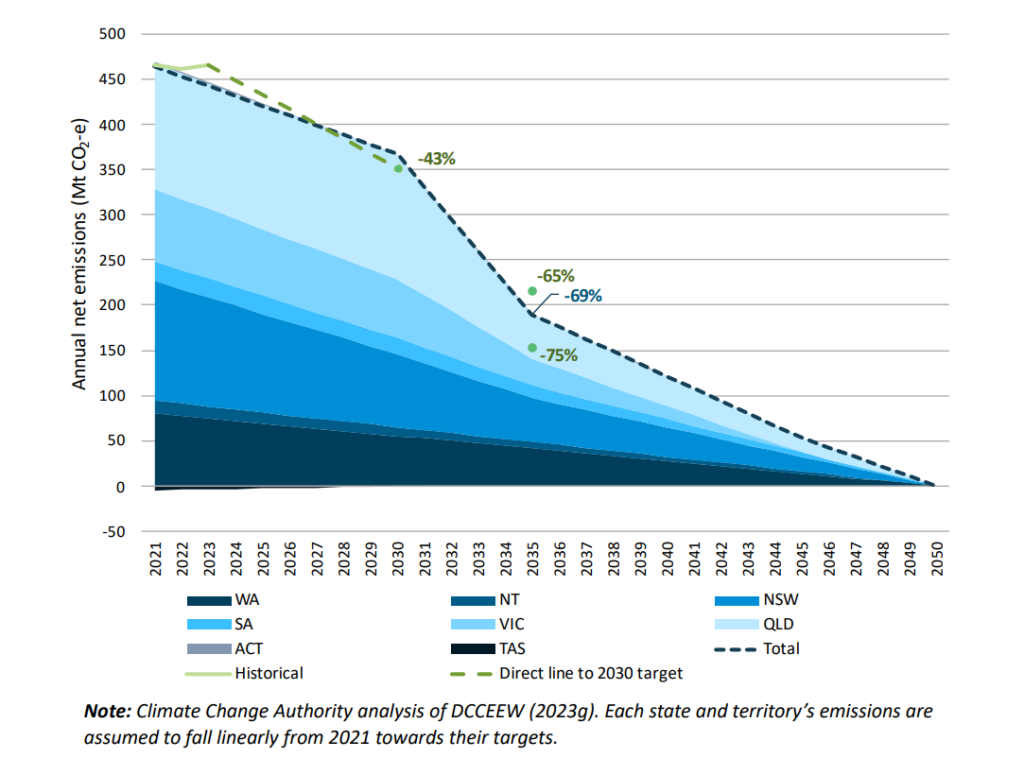Share this article
In 2025, Australia will be submitting its 2035 emissions target and Nationally Determined Contribution (NDC). It’s critical that industry leaders keep track of the latest developments underpinning Australia’s NDC development – it will dictate the near-term future of Australia’s climate policy, drive to Net Zero and be a key indicator of emerging compliance trends.
Setting the 2035 emissions target is a carefully considered process; the Climate Change Authority (CCA) is considering various pillars of international considerations, wellbeing and non-economic impacts, sectoral decarbonisation pathways, and economic impact to inform the NDC.
While it’s no small feat, early indications of the Net Zero trajectory the government may be considering can be gleaned from two recent publications:
- Australia’s 2023 emissions projection report published by the Department of Climate Change, Energy, the Environment, and Water (DCCEEW) in November
- 2024 Issues Paper: Targets Pathways and Progress published by the CCA in April.
In the emissions projection report, a BAU modelled scenario suggests that Australia’s 2035 emissions reduction could be 49% from 2005 levels by 2035. A more ambitious scenario takes this number to 53%.
The CCA issues paper suggests an ambitious and achievable target would be in the range of 65-75% below 2005 levels.

Image: CCA – Scenarios and 2035 emissions reduction targets
But is this 2035 emissions target robust enough?
Can we achieve it, and does it do our fair share of the global work to be done?
Or will we see an increase in ambition as we factor in other major trends?
Four key things to know about the 2035 emissions target
1. States and other jurisdictions will drive accelerated emissions reduction
While the national NDCs will need to be conservative, we are already seeing a ramping up in state-based ambitions – Queensland proposing 75% emissions reduction by 2035, NSW target of 70% emissions reduction by 2035, Victoria aiming for 75-80% emissions reduction by 2035 and Net Zero five years before the rest at 2045.
Once these targets are on track, Australia’s NDC could reasonably be expected to ramp up in ambition.
Further, with increasing ambition globally, Australia will face increasing pressure – UK’s 2035 emissions reduction target is 78% below 1990, for example.

Image: CCA Report – State and territory target trajectories
2. Land Use Change (LUC) will do a lot of heavy lifting
Modelling assumptions around the role of the land use, land use change and forestry, suggests it is and will, be a net carbon sink and could offset about 15% of Australia’s emissions in 2035.
Largely, this will be driven by preventing deforestation due to government policies. Organisations such as Climate Action Tracker criticise this, in part due to calculation uncertainty and the risks of relying on this sector so heavily to achieve the target.
3. The projections will exceed our cumulative budget
In 2014 the Australian Climate Change Authority published a targets and progress review report that suggested a national emissions budget of 10.1Gt CO2e between 2013 and 2050.
According to National Greenhouse Gas Inventory (NGGI) reporting, we emitted approximately 4.6 Gt between 2013 and 2021. DCCEEW modelling for Australia’s 2023 emission projections suggests the BAU scenario will use 4.3 GtCO2e between 2021 and 2030 alone.
These figures indicate the stark reality that it is unavoidable – we will exceed the initial cumulative budget in a few years after 2030.
4. Global calls for more ambitious progress and a 2040 target
Increasing calls for a 2040 Net Zero Target are being made (including the UN Secretary General’s Climate Acceleration Agenda), and the Climate Council of Australia is calling for 2035.
Net Zero 2040 is increasingly gaining momentum in the corporate sphere (especially for corporates using offsets to achieve these reductions – akin to Australia using the land sector to achieve targets).
According to the CCA issues paper, a Net Zero by 2040 target would correspond to a 77% on 2005 level target, through a straight line between current emissions and 2040.

Image: CCA – An approximation of countries’ 2035 emissions reductions relative to 2005 levels, based on straight-line trajectories from 2030 targets to Net Zero in 2050.
What does this all mean?
Australia’s NDC might be set around 65-75% below 2005 by 2035 if the recent issues paper is followed.
But with ramped up ambition globally and accelerated ambition in the state and corporate targets, a more appropriate target could be around 75% to 80%.
The increasing effects of climate change may also drive ambition. As climate change increasingly makes its presence felt, calls for more ambitious action will be made by all sides.
States that are facing increasing disaster response, corporates that have set science-based targets, developed countries who will face the brunt of climate change disproportionately and community organisations representing the needs of communities in transition.
This means that your business should start thinking towards what the government might commit to with its 2035 emissions target soon.
What action should your business take to prepare now?
With the update 2035 NDCs due next year, your business should start to review your emissions reduction modelling and planning and review your company’s target.
It’s worth looking at the proposed range for the 2035 NDCs as covered earlier and considering the following:
- Does your organisational ambition align with the proposed ranges published by the NDCs, or do you comparatively fall short?
Connecting the dots between your 2030 target and your net zero target, might necessitate changes to your emissions reduction planning this decade and next.
- Do the different NDC ranges impact the business-as-usual assumptions that underpin your modelling?
Core to setting robust and defensible targets, is understanding your business-as-usual emissions projections. Some assumptions underpinning this may need updating in light of the proposed 2035 NDCs.
In our next article, we build on these and unpack the differences between carbon accounting of a National Inventory and an Organisational Inventory, and thus why and how NDCs can be guideposts for your company’s ambition and planning.
Need help with next steps?
If you’d like to learn more, or need guidance with emissions reduction, target setting or your broader sustainability initiatives please reach out to our experts our experts we’re here to help.

